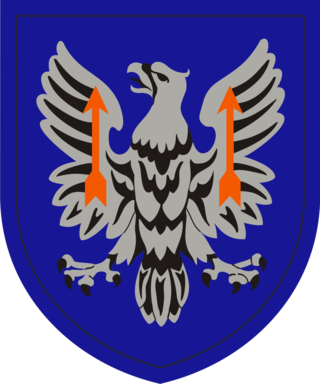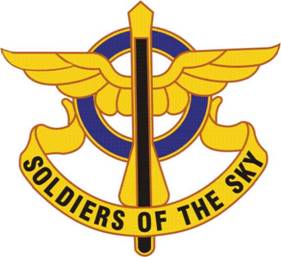
The 3rd Infantry Division (3ID) is a combined arms division of the United States Army based at Fort Stewart, Georgia. It is a subordinate unit of the XVIII Airborne Corps under U.S. Army Forces Command. Its current organization includes a division headquarters and headquarters battalion, two armored brigade combat teams, one aviation brigade, a division artillery, a sustainment brigade and a combat sustainment support battalion along with a maneuver enhancement brigade. The division has a distinguished history, having seen active service in World War I, World War II, the Korean War, and the Global War on Terror. The Medal of Honor has been awarded to 61 members of the 3rd Infantry Division, making the division the most honored in the Army.

The 1st Infantry Division (1ID) is a combined arms division of the United States Army, and is the oldest continuously serving division in the Regular Army. It has seen continuous service since its organization in 1917 during World War I. It was officially nicknamed "The Big Red One" after its shoulder patch and is also nicknamed "The Fighting First." The division has also received troop monikers of "The Big Dead One" and "The Bloody First" as puns on the respective officially sanctioned nicknames. It is currently based at Fort Riley, Kansas.

The 1st Cavalry Division is a combined arms division and is one of the most decorated combat divisions of the United States Army. It is based at Fort Cavazos, Texas. It was formed in 1921 and served during World War II, the Korean War, the Vietnam War, the Persian Gulf War, with the Stabilization Force in Bosnia-Herzegovina, in the Iraq War, in the War in Afghanistan as well as Operation Freedom's Sentinel and Operation Inherent Resolve. As of July 2023, the 1st Cavalry Division is subordinate to III Armored Corps and is commanded by Major General Kevin D. Admiral.

The 187th Airborne Infantry Regiment (Rakkasans) is a regiment of the 101st Airborne Division.

The 1st Battalion, 227th Aviation Regiment is an attack helicopter battalion of the Combat Aviation Brigade, 1st Cavalry Division. The battalion is an AH-64 Apache battalion based at Fort Cavazos, Texas.
The 2nd Battalion, 227th Aviation Regiment fly the Sikorsky UH-60 Black Hawk and the Boeing CH-47 Chinook. It provides aerial C3 support, limited air assault, aeromedical evacuation and air movement for the 1st Cavalry Division.

Below is an estimated list of the major units deployed within the Multi-National Force – Iraq and other United States military units that were operating in Iraq under the U.S. Central Command (USCENTCOM) in 2009, during the Iraq War.

The 8th Cavalry Regiment is a regiment of the United States Army formed in 1866 during the American Indian Wars. The 8th Cavalry continued to serve under a number of designations, fighting in every other major U.S. conflict since, except World War I, when it was not deployed to Europe because it was already engaged in the Punitive Expedition in Mexico from 1916 to 1920. It is currently a component of the 1st Cavalry Division.

The Combat Aviation Brigade, 1st Infantry Division is the Army Aviation formation of the United States Army's 1st Infantry Division. The current commander of this brigade is Colonel Chad P. Corrigan.

The 3rd Brigade Combat Team, 1st Cavalry Division is a combined arms armored brigade of the 1st Cavalry Division based in Fort Cavazos, TX. Major equipment includes the M1A2SEP Tanks, M2A3 & M3A3 Bradley infantry fighting vehicles, M109A7 Paladin howitzers, and M1114 up-armored Humvees.
The 229th Aviation Regiment is an aviation unit of the United States Army.

The 1st Squadron, 75th Cavalry Regiment is a United States Army cavalry squadron established in 2004. It is the Reconnaissance, Surveillance and Target Acquisition Squadron (RSTA) squadron of the 2nd Brigade Combat Team "Strike" ♥, 101st Airborne Division. It performs reconnaissance and cavalry missions in support of that brigade.

The 12th Combat Aviation Brigade is a Combat Aviation Brigade of the United States Army. It was first organized as the 12th Aviation Group at Fort Moore, Georgia, on 18 June 1965.

The 1st Armored Division Sustainment Brigade is a sustainment brigade of the United States Army based at Fort Bliss, Texas. It provides logistics support to the 1st Armored Division.

The 4th Battalion 227th Aviation Regiment is an attack reconnaissance battalion, also known as 4-227 ARB supporting the 1st Cavalry Division. They fly the AH-64D Apache Longbow and are based at Fort Cavazos, formerly Fort Hood, Texas.
In 2009, the United States and NATO International Security Assistance Force (ISAF) coalition, along with Afghan National Army forces, continued military operations against the Taliban in Afghanistan. 2009 marks the eighth year of the War in Afghanistan, which began late in 2001. And 75th ranger regiment is also in Afghanistan as of 2018

The Combat Aviation Brigade, 101st Airborne Division is a Combat Aviation Brigade (CAB) of the United States Army. It was first organized in July 1968 as an aviation group and stands as the most decorated aviation unit in the United States Army. It was redesignated an aviation brigade in 1986. It has served in almost every single military operation since the Vietnam War. In support of the Global War on Terror, the CAB has distinguished itself as the military's premiere combat aviation unit during its two deployments to Iraq and five deployments to Afghanistan. The brigade has flown hundreds of thousands of hours during these combat tours, transporting millions of troops around the battlefield and providing close air support/aerial reconnaissance. The 101st broke its own record for longest air assault in history during the invasion of Iraq in 2003. Previously, the longest air assault was conducted in 1991 during Operation Desert Storm.

The 11th Expeditionary Combat Aviation Brigade is a Combat Aviation Brigade in the United States Army Reserve. The unit's lineage can be traced to the prior lineage and insignia of the 11th Aviation Group which was last headquartered in Illesheim, Germany in 2005. It is one of two aviation brigades of Army Reserve Aviation Command. The brigade consists of a headquarters company, two Black Hawk assault battalions, and one fixed wing battalion. The brigade was activated in its current formation on 16 September 2016.

The 3rd Aviation Regiment is a regiment of the United States Army Aviation Branch. It operates the Boeing AH-64 Apache attack helicopter, Sikorsky UH-60 Black Hawk helicopter, and Boeing CH-47 Chinook helicopter. It has been associated with the 3rd Infantry Division for some time.

The 10th Aviation Regiment is an aviation regiment of the U.S. Army.



















